
by bungalow101 | Jan 3, 2023 | The History
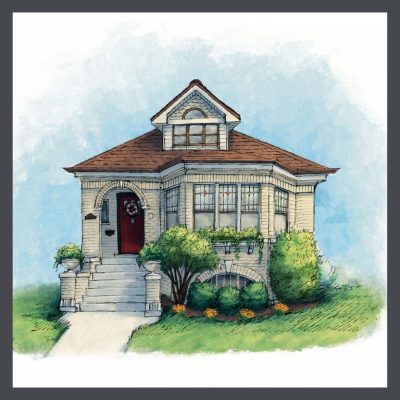 The story of the Chicago bungalow isn’t about the houses, it’s about the humanity. I call it, “Grits & girdles history.”
The story of the Chicago bungalow isn’t about the houses, it’s about the humanity. I call it, “Grits & girdles history.”
Because our houses tell the stories of the lives of the people who built them & how they lived, worked & formed their communities- the intimate details if you will. (In fact, I produced a historic documentary film about a bungalow neighborhood in Tampa that was full of the juicy goings- on of the time.)
The Chicago bungalow may be the most striking example of regional uniqueness to be found in the United States, in terms of single-family housing. There is no mistaking a Chicago bungalow which has many character defining features that are simply not seen in other areas of the country because they do not provide the same history or environment.
These features were developed out of the events that happened in the city, the natural resources & challenges, the man-made materials & technology that were available in the area during the period of their planning & construction.
THE STORY
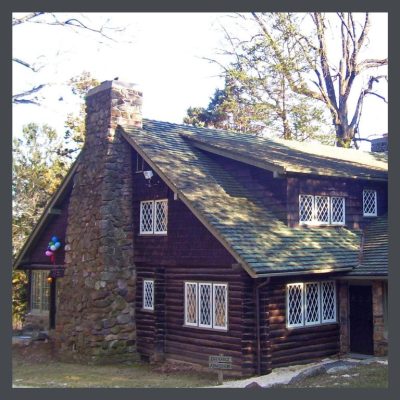 There were a great many influences that resulted in the Chicago bungalow, the first of course, being the Arts & Crafts Movement in England, a pushback against the overproduction of shoddy goods that characterized the Industrial Revolution.
There were a great many influences that resulted in the Chicago bungalow, the first of course, being the Arts & Crafts Movement in England, a pushback against the overproduction of shoddy goods that characterized the Industrial Revolution.
The philosophy & design of the Movement were imported to the U.S. by Gustav Stickley, a furniture designer, writer & innovator. The Chicago bungalow veers wildly from Stickley’s ideal of a log cabin in the woods as they are built of brick & sit on a 125’-by-25’ lot in a city, which by 1910 was the home to over 2 million souls, the second largest in the United States, after New York. Not the low, wide structures of the American West on their expansive lawns, nor Stickley’s rock chimneyed log house in the woods, but bungalows they were-tidy compact brick muffins sitting prettily on the narrow city lots.
The Chicago bungalow provided exactly the modest refuge that was needed by the working class at the time, many of them immigrants, who had come to work in the factories & meat packing plants. Nearly 80,000 homes were built, each one with its own subtly distinctive charm & character.
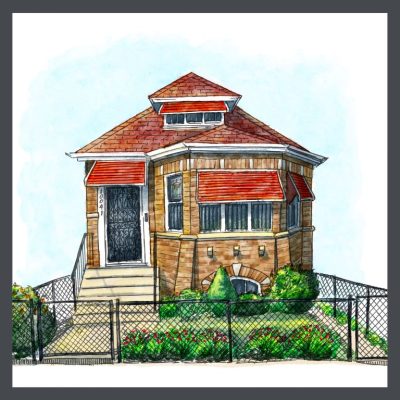 The next great influence was the Chicago Fire of 1871, which started in a barn & burned for over a day, killing 300 people. Because of the pressure to build houses to accommodate the growing population, buildings had been constructed using quickly assembled, cheaply constructed balloon-framing, with studs running from the foundation to the roof. Fire travels upward & there was nothing to stop it as it roared up the walls & turned the houses to ash, making a third of the city homeless. After this disaster, the city enacted new building codes & rapidly rebuilt the city according to those codes. With brick.
The next great influence was the Chicago Fire of 1871, which started in a barn & burned for over a day, killing 300 people. Because of the pressure to build houses to accommodate the growing population, buildings had been constructed using quickly assembled, cheaply constructed balloon-framing, with studs running from the foundation to the roof. Fire travels upward & there was nothing to stop it as it roared up the walls & turned the houses to ash, making a third of the city homeless. After this disaster, the city enacted new building codes & rapidly rebuilt the city according to those codes. With brick.
When you think of a Chicago bungalow, brick does come instantly to mind. The area was gifted with an abundance of clay by the glaciers that moved through the area over 10,000 years ago leaving their assorted debris so the resultant, fired bricks are speckled in a variety of colors. To satisfy the demands of the building boom in 1910, nearly a billion of these cheap bricks were produced. When I say cheap I mean cheap, averaging $7 per thousand while the better, more homogenous brick sold for as high as $35 per thousand.
So, builders took advantage of this cheap brick & used it to build areas that were not so visible, like foundations, structural walls, chimney flues & the back & sides of the house. Because Chicago is centrally located & a railroad hub, it was easy to bring all types of brick from all over the country so the front facades of bungalows show a charming diversity of brick types.
THE CHICAGO BUNGALOW STORY-ILLUSTRATED
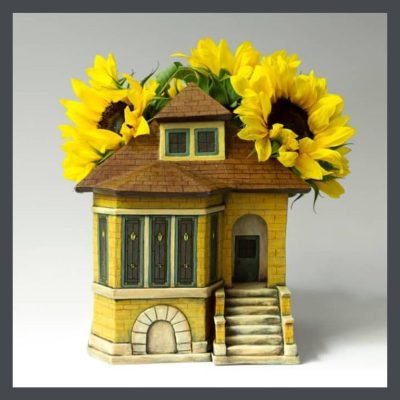 The images that you see here are created by Wonder City Studio by Phil Thompson & his wife Katie who are obviously in love with their town. He has created many drawings of Chicago buildings of all types, including capturing the sweet, sturdy hominess of the bungalow.
The images that you see here are created by Wonder City Studio by Phil Thompson & his wife Katie who are obviously in love with their town. He has created many drawings of Chicago buildings of all types, including capturing the sweet, sturdy hominess of the bungalow.
He features prints of his representations of the city, but, he also does commissioned portraits of homes anywhere. When I lived in Eagle Rock we had plein air painters (an Eagle rock tradition, historically) lining the walking tour route, many painting the homes of the tour hosts. The paintings were then auctioned for charity at an exhibit later & the homeowners were always the highest bidders for the paintings of their own homes. A portrait captures the soul of a house much more eloquently than a photograph (well, than a photograph of a mere mortal. You have to allow for the work of Alex Vertikoff.)
But, wait, there’s more! Katie Lauffenburger, wife, mom & founding partner of Wonder City Studio, will sculpt a custom planter Mini-Me of your home. And you can put flowers in it!
Although we may dream of living in our homes forever, sometimes life necessitates change & having either a beautiful drawing or a tiny 3-D model of it could mend a broken heart.
THE CHICAGO BUNGALOW ASSOCIATION HAS THE FULL STORY
What I can tell you about Chicago bungalows is a tiny fraction of the knowledge that the Chicago Bungalow Association posses & teaches. I just wanted to whet your appetite for this architectural form, unique in all the world to the Windy City.
 STAY IN THE BUNGALOW KNOW!!!
STAY IN THE BUNGALOW KNOW!!!
Sign up for our newsletter & receive our FREE E-book, 7 VITAL Things to Do Before You Hire a Contractor.
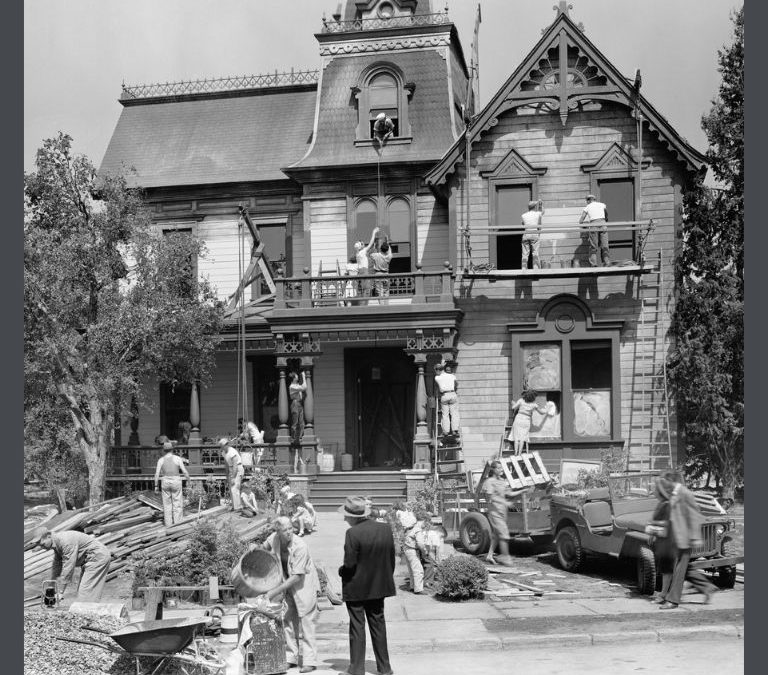
by bungalow101 | Dec 27, 2022 | Doors & windows, The History
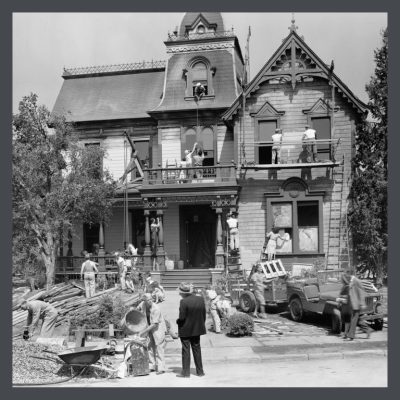 From their framing to their siding to their doors & windows to their built-ins & their flooring, our old houses, are built of old growth wood. Thousands of board feet of it.
From their framing to their siding to their doors & windows to their built-ins & their flooring, our old houses, are built of old growth wood. Thousands of board feet of it.
“Old growth.” What does that mean?
Let’s have a tree history lesson. Fossils show that the first tree-like plants, with vascular systems that transported water & nutrients, allowing the plants for the first time to rise up off the ground (Think moss.) & to form trunks & branches, developed 400 million years ago. Their evolution since then included the development of seeds & true woody stems.
Then,
Over 300 million years ago: The earliest conifers (i.e., cedar, fir, pine, redwoods & others) appear.
67 million years ago: Evidence of the first maple trees.
56 million years ago: Evidence of the first oak trees.
They continued to evolve & to create the great forests that covered most of America, generation after generation contributing to the next as they produced seeds, died & decayed, becoming part of the rich soil of the virgin woodland.
REDWOODS- THE LONGEST LIVING OF OLD GROWTH WOOD
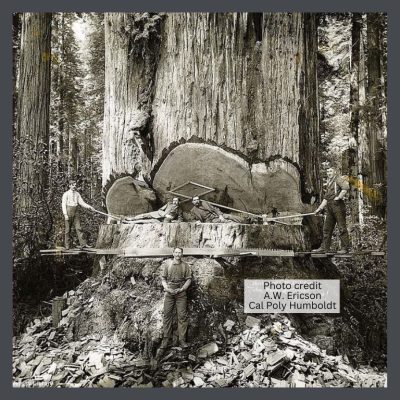 Let’s start with the Redwood, one class being the oldest plants on earth, living from about 800 to 3,200 years. On the west coast, before they were chopped to build our houses, they played an important part in the lives of early indigenous peoples who revered them, building structures from fallen trees. Native elder Minnie Reeves called them “a special gift from the Great Creator. Destroy these trees and you destroy the Creator’s love . . . and you will eventually destroy mankind.”
Let’s start with the Redwood, one class being the oldest plants on earth, living from about 800 to 3,200 years. On the west coast, before they were chopped to build our houses, they played an important part in the lives of early indigenous peoples who revered them, building structures from fallen trees. Native elder Minnie Reeves called them “a special gift from the Great Creator. Destroy these trees and you destroy the Creator’s love . . . and you will eventually destroy mankind.”
When California became a state in 1850, there were nearly 2 million acres of redwood forest. San Francisco was built twice with redwood, before & after the quake & fire of 1906. But the worst was yet to come. During the first half of the 20th Century when California experienced a major building boom, the redwood forest suffered its greatest losses, with trains of lumber heading south as trains of oranges headed north.
Going into the 21st Century, only 5 percent of the old growth forest still stood, thankfully protected on public lands.
In modern times, redwood farms produce wood for lumber, however, this new wood does not have the same high levels of toxic tannins, a type of bitter, astringent chemical compounds which protect the trees from fungus & insects & decrease its susceptibility to rot.
Selective cutting of young trees is permitted on redwood farms but these trees do not have enough age on them to acquire the decay & insect resistant properties of the old growth. If you want the original, old growth wood, you must buy it second-hand, salvaged from old buildings that some uninformed person has chosen to demolish.
OTHER OLD GROWTH CONIFERS IN OLD HOUSES
The Douglas fir forests of the Northwest were treated just as casually. The timber industry, both logging & milling’ developed into a huge industry. The quantities were regarded as unlimited, if they were regarded at all in the push to maximize profit. As harvesting & transportation technologies developed, so did the quantity of forest land destruction increase.
It wasn’t until the 1880’s that conservation of timber supplies was considered. National forests were established & research into good forest practices began.
OAK
 The Domesday Book of 1086, a survey ordered by William the Conqueror to record his holdings, indicated a forest cover of 15%, By the start of the next millennium, this coverage had dropped to 5%.
The Domesday Book of 1086, a survey ordered by William the Conqueror to record his holdings, indicated a forest cover of 15%, By the start of the next millennium, this coverage had dropped to 5%.
In the 17th Century, as thousands of colonists arrived in the United States from England, they placed heavy demands on the forests taking huge trees, some hundreds of years old, of many species for lumber not only for building but also for fuel. Additionally, they cleared lands for agriculture & livestock.
Additionally, after the Industrial Revolution, potash, potassium carbonate derived from burned wood was in high demand in the colonies & in England where they had already decimated their forests. By the early 1800’s, the pre-revolutionary American colonies were providing England with more than 60% of its potash.
The construction boom after WW I, especially during the mid-1920’s, furthered reduced our forest resources. You can read about pine’s story, in the forests of the Eastern U.S., here.
FARMED WOOD VS OLD-GROWTH WOOD
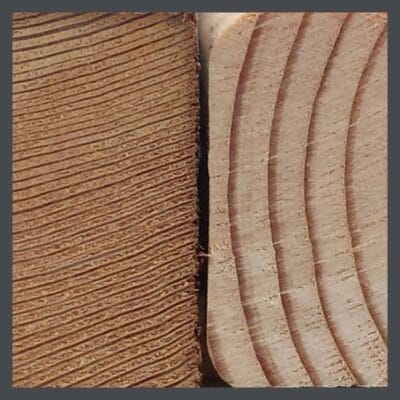 Trees are planted in man-made forests with the purpose of generating a large amount of product, fast. These farms do not replicate the ecology of the natural forest. Generally they are one species only, & all the trees are planted at the same time. The trees are planted in rows spaced to allow maximum sunlight & water exposure so they grow very fast. The old forests allowed trees to grow slowly, putting on more tightly-packed growth rings
Trees are planted in man-made forests with the purpose of generating a large amount of product, fast. These farms do not replicate the ecology of the natural forest. Generally they are one species only, & all the trees are planted at the same time. The trees are planted in rows spaced to allow maximum sunlight & water exposure so they grow very fast. The old forests allowed trees to grow slowly, putting on more tightly-packed growth rings
Because of this, new growth wood does not have the strength, stability nor the decay & insect repelling properties of old growth wood- not to mention the beauty. But. stick with me here. I have a theory about additional environmental factors that made the virgin forests a much better place for trees.
The conditions in the old forests had evolved over millions of years. Co-evolution is the evolving of all the parts of an ecosystem to assist each of its parts survive better. i.e., evolutionary change over time, benefiting each interacting member, usually involving different species. Tree farms lack this dynamic. They are the new kids in school without a support system, not oriented to their environment, & growing in unnatural conditions.
The virgin forest is home to many tree species as well as hundreds of different insects, animals & microbes. All of these organisms have made reciprocal adaptive changes in cooperation with one or more other species, over the millennia, helping one another to survive with greater & greater efficiency.
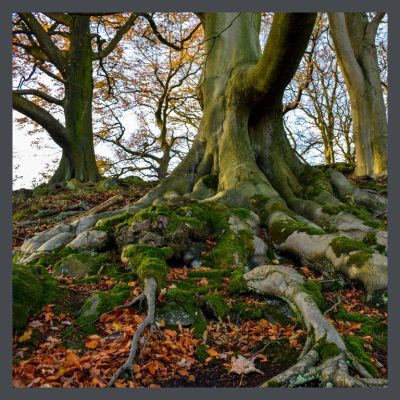 Much of this mutual adaptation involves microorganisms, the fungi that break down the fiber of the dead trees & turn them into nutritious soil, but also form a communication network for the trees. Watch this short video by National Geographic that explains how trees connect & share with one another.
Much of this mutual adaptation involves microorganisms, the fungi that break down the fiber of the dead trees & turn them into nutritious soil, but also form a communication network for the trees. Watch this short video by National Geographic that explains how trees connect & share with one another.
Trees do not stand alone, competing with one another for sunlight, water & nutrients. Rather, the forest is almost like a single organism, the different trees interacting with one another, both within & outside their own species, through their roots & the fungal networks that connect these roots. They exchange communication & nutrients through this network, with the larger, old Mother trees forming the hubs. As an example, Douglas firs share excess sugars with the leafless birches in the spring & fall, & in return, the birches send sugars to the Douglas-firs in the summer, via the fungi underground.
Here’s my crazy theory. The health of the human body depends on the quantity & diversity of the microbes that live in the gut. To build a strong, healthy body, one needs a strong healthy microbiome- the colony of microorganisms within the body. This is a lovely short video of 2 Stanford researchers who have discovered much of what is known in this science. They have a big picture of bacteria over the fireplace in their home.
My hypothesis is that lumber from a tree grown in the virgin forest is better, stronger, more stable, more decay & insect resistant not just because it is old & bigger, but because it has grown up with a Mother, a family, neighbors & friends in the form of an active ecosystem that has had millions of years to get it right. “It’s not better because it’s old, it’s old because it’s better.”
What do you think?
FOR MORE INFORMATION ON OLD GROWTH WOOD, VISIT OUR OLD HOUSE RESTORATION VIDEOS- OLD GROWTH WOOD here.
 STAY IN THE BUNGALOW KNOW!!!
STAY IN THE BUNGALOW KNOW!!!
Sign up for our newsletter & receive our FREE E-book, 7 VITAL Things to Do Before You Hire a Contractor.
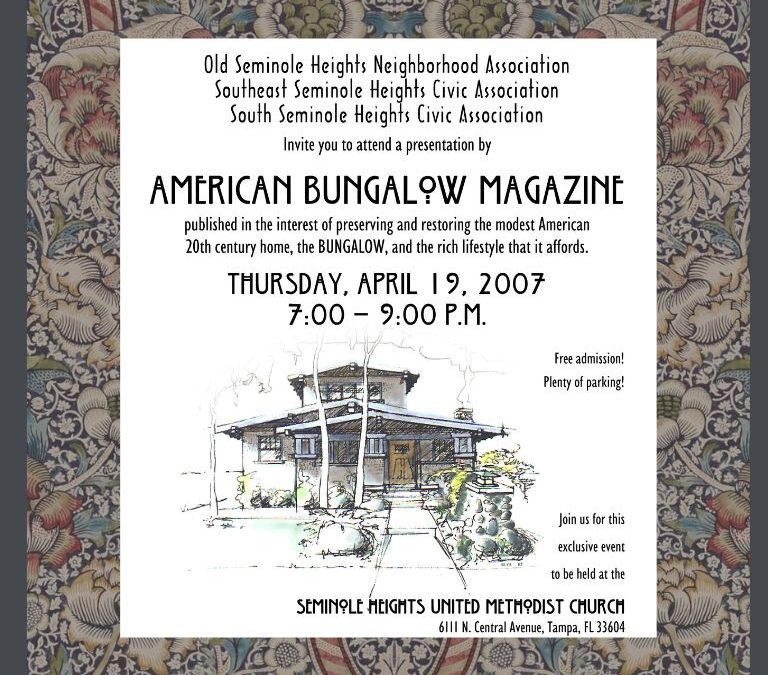
by bungalow101 | Dec 10, 2022 | Preservation groups, The History
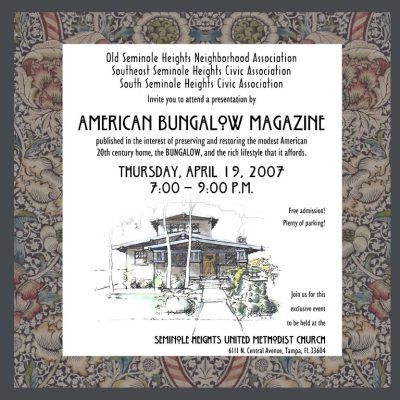 What seems like a lifetime ago, with a great amount of help from my friends in the 3 areas that make up the bungalow neighborhood of Seminole Heights, in Tampa, Florida, I produced an American Bungalow Magazine event. I had coaxed, cajoled, pleaded with the editor to have genius photographer, Alex Vertikoff come to Central Florida to shoot our houses. I coordinated with 4 other neighborhoods in Tampa, St. Petersburg & Lakeland to make it worth their while to drive all the way across the country. Publisher John Brinkmann came to speak to us at a wonderful event in our historic church.
What seems like a lifetime ago, with a great amount of help from my friends in the 3 areas that make up the bungalow neighborhood of Seminole Heights, in Tampa, Florida, I produced an American Bungalow Magazine event. I had coaxed, cajoled, pleaded with the editor to have genius photographer, Alex Vertikoff come to Central Florida to shoot our houses. I coordinated with 4 other neighborhoods in Tampa, St. Petersburg & Lakeland to make it worth their while to drive all the way across the country. Publisher John Brinkmann came to speak to us at a wonderful event in our historic church.
I had been a devotee of American Bungalow for a number of years. They had attended our first home tour in Eagle Rock & published a beautiful article on the Hanson Puthuff house, displayed on the poster to the left.
In my Tampa neighborhood, I enjoyed the privilege of being the magazine distributor. Every quarter the magazines would arrive in a big box, & I would peddle them around the neighborhood at events & meetings & deliver to people’s homes when requested. It was a great way to meet folks, educate Tampa on historic houses & support the valuable work of the magazine.
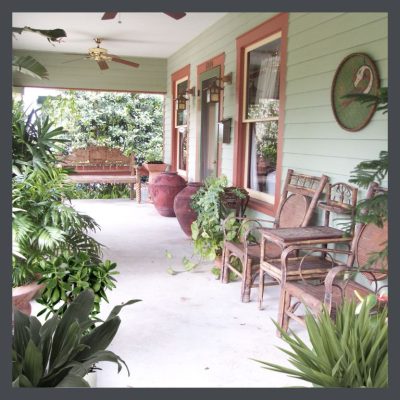 The neighborhoods pitched in, volunteering their bungalows for the project. I recruited writers for all the articles & each author (or group of authors) gathered material & researched their areas.
The neighborhoods pitched in, volunteering their bungalows for the project. I recruited writers for all the articles & each author (or group of authors) gathered material & researched their areas.
My neighborhood, Seminole Heights produced some beautiful houses & the authors encouraged a woman who had lived in the neighborhood in the early years to tell her story- A Place to Grow Up. Her sweet childhood voice & photos brought those times to life. I am lucky enough to have another story from her to tell you here, Childhood Pets in My Bungalow Neighborhood.
The article tells the story of how the neighborhood association began- a response to the threatened destruction of many bungalows along one of our central corridors. By the time I arrived 25 years later, it was a powerful force for preservation & revitalization. When I say, “Do something about it,” I have seen firsthand what can be done by a group of committed citizens.
The neatest part about the article occurred when the editor sent me a proof & there was my front porch in a 2-page color spread opening a piece in my favorite magazine, American Bungalow! There were a couple shots of my living room too, but they were pretty small. Finally, at the age of 60 my dream of being a centerfold was realized! And it was one that I could show my mother!
AMERICAN BUNGALOW MAGAZINE VISITS A HISTORIC FARMHOUSE IN YBOR CITY
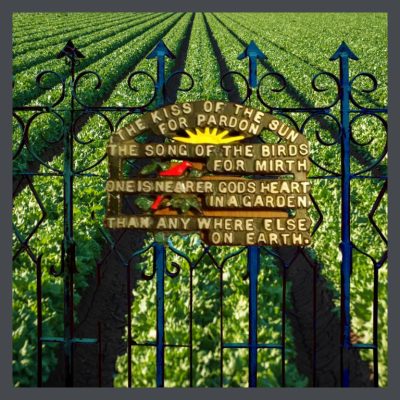 In the center of Tampa is a farm with a bungalow farmhouse, built by Sicilian immigrants, Salvatore & Vittoria Giunta, who arrived in Tampa in 1907. Peasant farmers, they hoped for a better life for themselves & their children in American. Work was plentiful in Ybor City in the cigar factories & farms & they worked at a variety of jobs, saving money until they could buy land. Self-sufficient, they raised heirloom vegetables & herbs with which they fed their family & sold the surplus to supplement their income. At one time, this area, now residential was dubbed “the breadbasket of Ybor,” providing food for up to 10,000 cigar factory workers. After time they purchased more land & in 1924, the house was built just in time for the family to enjoy their Christmas together. The farm up to this day, almost 100 years later, is still being worked by the two granddaughters, who live in the old farmhouse.
In the center of Tampa is a farm with a bungalow farmhouse, built by Sicilian immigrants, Salvatore & Vittoria Giunta, who arrived in Tampa in 1907. Peasant farmers, they hoped for a better life for themselves & their children in American. Work was plentiful in Ybor City in the cigar factories & farms & they worked at a variety of jobs, saving money until they could buy land. Self-sufficient, they raised heirloom vegetables & herbs with which they fed their family & sold the surplus to supplement their income. At one time, this area, now residential was dubbed “the breadbasket of Ybor,” providing food for up to 10,000 cigar factory workers. After time they purchased more land & in 1924, the house was built just in time for the family to enjoy their Christmas together. The farm up to this day, almost 100 years later, is still being worked by the two granddaughters, who live in the old farmhouse.
Though the farm is a prime piece of property in a very desirable location the sisters stand firm against offers from developers & in 2020, City Council agreed with their request to designate the farm a historic landmark offering some protection against future development. Please watch this beautiful video to learn more about the history of the family & the farm & best of all, to meet the sisters.
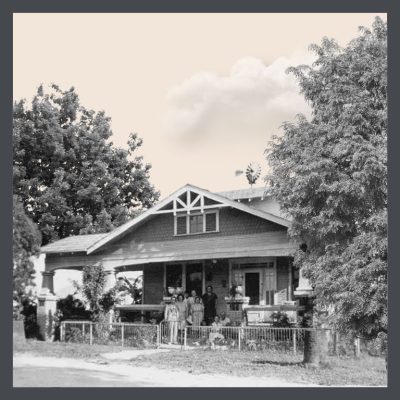 Make no mistake about it. This is a farmhouse. The floors are not glossy quartersawn oak but are covered with linoleum & the usual Stickley pieces that you see pictured in American Bungalow are not in evidence. I spent 2 days helping the sisters stage the house for the shoot (No, Alex didn’t know about know this!) I pulled all the family antiques- a charming deco armoire, an old tricycle, a child’s chair, from the bedrooms & arranged them in the family gathering room off the kitchen. A century ago. their father had made a wooden boat to sail down the flooded Tampa streets, & I pulled it from a closet & had a shelf built for it to be mounted over a quilt-covered chair in the corner.
Make no mistake about it. This is a farmhouse. The floors are not glossy quartersawn oak but are covered with linoleum & the usual Stickley pieces that you see pictured in American Bungalow are not in evidence. I spent 2 days helping the sisters stage the house for the shoot (No, Alex didn’t know about know this!) I pulled all the family antiques- a charming deco armoire, an old tricycle, a child’s chair, from the bedrooms & arranged them in the family gathering room off the kitchen. A century ago. their father had made a wooden boat to sail down the flooded Tampa streets, & I pulled it from a closet & had a shelf built for it to be mounted over a quilt-covered chair in the corner.
In the kitchen sits a “Nana cabinet,” a traditional Sicilian piece in which were displayed the china, glassware & collectables of the grandmother of the house. This one was built by her son of recycled materials—wood slats from apple crates, curved glass sides from a discarded retail display case & the best part- it is topped with a decorative crown from an old circus wagon offered by a friend who just didn’t think that the cabinet looked complete.
The pieces were just stacked in the cabinet, with no attempt to display them. We spent several hours removing the items, carefully placing them on the kitchen table. I returned them one by one, showing each one to full advantage. These pieces hold the memories of family dinners of 3 generations & deserved to be elegantly celebrated.
The sisters are not artists. They are revered teachers, beloved daughters, dutiful sisters & aunts & hard-working farmers. They were astonished at how I managed to honor their family by displaying their heirlooms & photographs artfully.
It was one of the most wonderful experiences of my life.
The morning after John’s event in my neighborhood of Seminole Heights, he & I went for breakfast at the farm. John toured the house & admired the fields, lush with produce whose seeds were brought from Sicily 100 years before. He played fetch with the farm dog & chatted with the chickens. He was honored to have met the Giunta sisters & honored them in return with a beautiful article in the magazine.
THE AMERICAN BUNGALOW MAGAZINE PHILOSOPHY
“…it’s not about how big you live, it’s about how genuine you live. That’s what the magazine stands for.” – John Brinkmann, American Bungalow Magazine
I was thrilled to be able to provide him with the opportunity to visit a family that had lived so genuinely in their farmhouse bungalow for 3 generations.
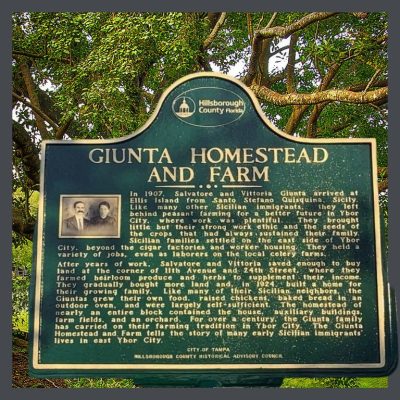 The plaque installed by the County reads:
The plaque installed by the County reads:
In 1907, Salvatore and Vittoria Giunta arrived at Ellis Island from Santo Stefano, Qisquina, Sicily. Like many other Sicilian immigrants, they left behind peasant farming for a better future in Ybor City where work was plentiful. They brought little but their strong work ethic and the seeds of the crops that had always sustained their family. Sicilian families settled on the east side of Ybor beyond the cigar factories and worker housing. They held a variety of jobs, even as laborers on the local celery farms.
After years of work, Salvatore and Vittoria saved enough to buy land at the corner of 11th Avenue and 24th Street, where they farmed their heirloom produce and herbs to supplement their income. They gradually bought more land, and in 1924, built a home for their growing family. Like many of their Sicilian neighbors, the Giuntas grew their own food, raised chickens, baked bread in an outdoor oven, and were largely self-sufficient. The homestead of nearly an entire block contained the house, auxiliary buildings, farm fields and a orchard. For over a century the Giunta family has carried on their farming tradition in Ybor City. The Giunta homestead and farm tells the story of many Sicilian immigrants’ live in Ybor City.
TIP: READ MORE ABOUT MY WILD PRESERVATION LIFE HERE.
 STAY IN THE BUNGALOW KNOW!!!
STAY IN THE BUNGALOW KNOW!!!
Sign up for our newsletter & receive our FREE E-book, 7 VITAL Things to Do Before You Hire a Contractor.
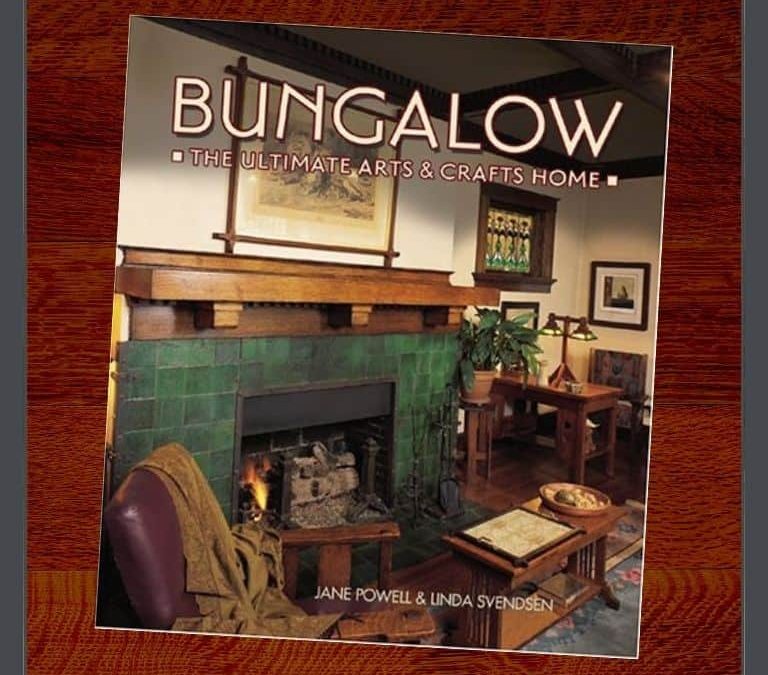
by bungalow101 | Jun 16, 2022 | Doing it the right way, The History
by Jane Powell, author & Linda Svendsen, photographer
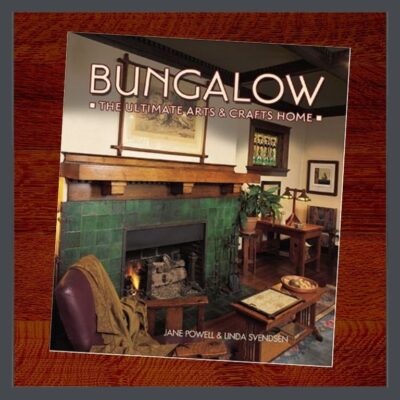 This book, BUNGALOW: THE ULTIMATE ARTS & CRAFTS HOME, was Jane’s most impressive work & it is majestic, with 285 large, glossy pages. She referred to it as “The Big Book of Bungalows” & I’m not certain that she was enthralled with the publisher’s final choice of title.
This book, BUNGALOW: THE ULTIMATE ARTS & CRAFTS HOME, was Jane’s most impressive work & it is majestic, with 285 large, glossy pages. She referred to it as “The Big Book of Bungalows” & I’m not certain that she was enthralled with the publisher’s final choice of title.
Hewn & Hammered’s review of the book opined, “The book is written with humor and warmth, never taking its subject matter too seriously, which is a welcome alternative to many other books in the genre that treat these buildings as museum exhibits before their original purpose (and, in most cases, only purpose) as homes.”
A quote from an Amazon reader: “This is my first contact with Powell/Svendsen’s books, and while it is indeed coffee table size (it needs to be large to accommodate the beautiful photography) it is so charming and readable that, without so intending, I READ it (in one sitting, yet). We have several other books of gorgeous bungalows, many with the same houses as subjects, with accompanying commentary equivalent to dry stale cornflakes; this one is crumpets and cream. Like others documenting bungalow style architecture, this book is not intended as a construction or instruction manual, but as inspiration. For admirers of bungalow style and for those seeking a picture to replace the thousand words BUNGALOW: THE ULTIMATE ARTS & CRAFTS HOME is an easy choice.”
While her other books are much more instructional, there is much factual information to be gained from reading this book. Jane is an amusing teacher so you don’t notice at all that you are sitting in class.
FOREWORD TO BUNGALOW: THE ULTIMATE ARTS & CRAFTS HOME
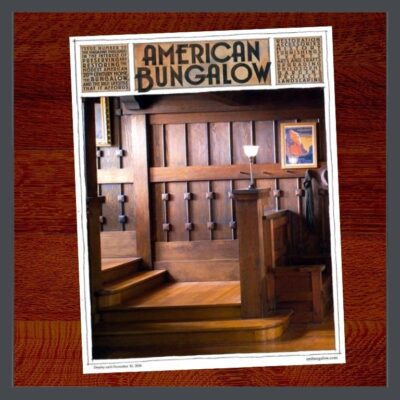 Jane introduces the book with some beautiful shots of bungalows by Linda Svendsen, including the impressive staircase of Jane’s bungamansion, the Sunset House in Oakland. Walking up these stairs, so sexy that they made the cover of American Bungalow, photographed by Alex Vertikoff, is an awesome experience. I wish this word had not been appropriated to mean, “like, totally cool” because the huge Doug Fir staircase is truly, “extremely impressive or daunting; inspiring great admiration, apprehension, or fear.” The workmanship is masterful, the dark wood lovely, & when you walk up these stairs, you are cocooned in the world of the wealthy 100 years ago. (Jane mentions, the builder was the owner of a lumber company so he got the wood wholesale, but still.)
Jane introduces the book with some beautiful shots of bungalows by Linda Svendsen, including the impressive staircase of Jane’s bungamansion, the Sunset House in Oakland. Walking up these stairs, so sexy that they made the cover of American Bungalow, photographed by Alex Vertikoff, is an awesome experience. I wish this word had not been appropriated to mean, “like, totally cool” because the huge Doug Fir staircase is truly, “extremely impressive or daunting; inspiring great admiration, apprehension, or fear.” The workmanship is masterful, the dark wood lovely, & when you walk up these stairs, you are cocooned in the world of the wealthy 100 years ago. (Jane mentions, the builder was the owner of a lumber company so he got the wood wholesale, but still.)
As Jane says about it, “… this book deals with the philosophy, history, & influences that led to the bungalow as we know it in North America. Don’t worry, it’s not very scholarly. Most it’s a celebration of bungalows & everything on them & in them, & the Arts & Crafts movement they represent. I think that you will enjoy the ride.”
And by “ride” she meant a purple PT Cruiser. Mine was red.
CHAPTER ONE: THE COLOR OF WIND
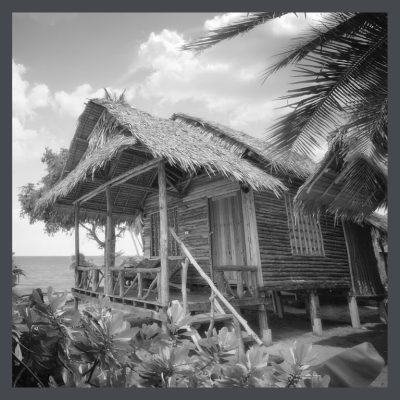 This chapter addresses, what is a bungalow? Well, it originated in India, & ended up in California inspired by a socialist design movement in Britain in the late 1800’s. Explaining that architecture isn’t simple, she answers this question by encouraging us to “Think outside the chicken” -by reading her book & viewing the images, we will just come to KNOW. It worked for me & whenever I feel wobbly, I come back to this book to get straightened out.
This chapter addresses, what is a bungalow? Well, it originated in India, & ended up in California inspired by a socialist design movement in Britain in the late 1800’s. Explaining that architecture isn’t simple, she answers this question by encouraging us to “Think outside the chicken” -by reading her book & viewing the images, we will just come to KNOW. It worked for me & whenever I feel wobbly, I come back to this book to get straightened out.
Going Native
A full description of the original bangala & the modifications made by the Europeans.
Getting Away From It All
The Industrial Revolution in Britain brought nostalgia for an idealized agrarian past.
The Seeds of Change
The Arts & Crafts Movement sprouts from the reverence for nature & ideas about design, & social & political reform.
CHAPTER TWO: IN FULL FLOWER
We learn about William Morris, the father of the Arts & Crafts Movement. There is a lovely quote about Morris which describes his many artistic passions & ends with, ..”& then he’ll do I don’t know what, but every minute will be alive.”
In my world, there is no greater compliment.
Pages of beautiful photos bring the copy to life as you learn to “Think outside the chicken” & begin to understand the soul of the bungalow.
Art for Art’s Sake
In this section Jane describes the Aesthetic Movement, which paralleled the A & C Movement, had the same roots & the same folks involved, but lacked the political & social philosophies of the latter.
I must admit to a great attraction to this design style. I see so much of the Arts & Crafts philosophy in the Aesthetic Movement & I really like their take on it. I especially like how its contrast of intricate small patterns inspired by nature complements the chunkier, more simple design of Arts & Crafts sharing the same inspiration.
In the Hare House, my Aesthetic collection adorned the dining room plate rails. In Tampa, I re-created the original divider shelves to display them.
The Bohemian Life
Jane is still in England, writing about the bungalows at the seaside that have acquired a bohemian reputation, representing a more simple life.
She stresses the fact that most of the Arts & Crafts houses were not bungalows, but looked to medieval designs for inspiration. It took Stickley to bring Arts& Crafts to America for it to assume it’s, uh, American form.
CHAPTER THREE: SMILING LAWNS & TASTEFUL COTTAGES
The Centennial Exhibition, held in 1876 spurred motivation for developing art & architecture that display American pride, though many bungalows clearly show European & Asian influence & you will see many images of this.
Global Inspiration, Indigenous Style
With the log cabin as inspiration, the bungalow was often more rustic. Jane continues on to describe the American flavor &unique local features found in bungalows across the country- with more of Linda’s lush photos.
CHAPTER FOUR: POPCORN & CAPITALISM
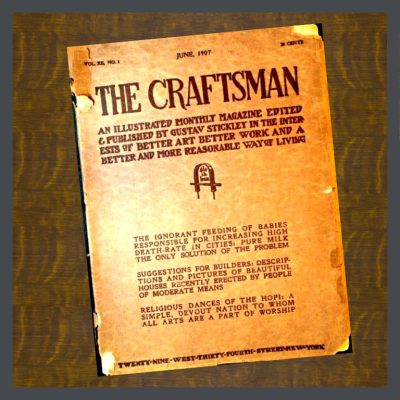 Ah! California, where the bungalow reached its full potential. She visits Northern & Southern California & it is here where we see my house in Eagle Rock.
Ah! California, where the bungalow reached its full potential. She visits Northern & Southern California & it is here where we see my house in Eagle Rock.
The Ideal Home
In this section she writes more about plan books & other publications as well as kit houses. The building boom of the 20’s was spurred by the street car, then the automobile.
Freedom of Assembly
More pre-cut buildings from a greater number of companies continued the bungalow boom. I must stress again that the images tell much of the story! You are seriously missing out by not having this book! Clinker bricks, limestone columns green-stained shingles & granite piers, Oh my!!!!!!!
Icon & Irony
More amazing photos & a look at how the A & C Revival has outlasted the original Movement. Hey, I’m glad that Stickley is getting the admiration & recognition that he did not receive in his later years. And while it’s on my mind, let me suggest that you watch this incredible documentary Gustav Stickley: American Craftsman.
CHAPTER FIVE: ON THE STREET
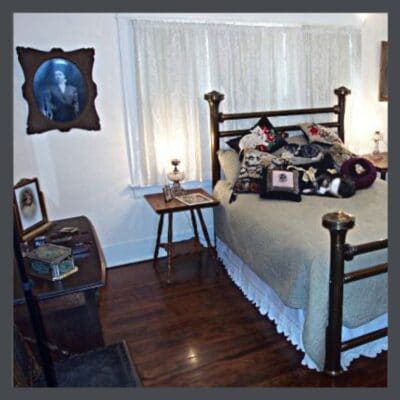 This is the longest chapter of BUNGALOW: THE ULTIMATE ARTS & CRAFTS HOME & I don’t want to wear you out, so I’ll cover it in one section.
This is the longest chapter of BUNGALOW: THE ULTIMATE ARTS & CRAFTS HOME & I don’t want to wear you out, so I’ll cover it in one section.
The porch, part of the Arts & Crafts ideal of the melding of nature with the indoors. The entry welcomes guests to enter & sit before the hearth. We see some beautiful fireplaces here of tile & of brick in various patterns. She goes to on talk about dining rooms showing an abundance of beautiful built-ins & rich wainscoting, including mine, the Hare House, on page 202. I had received the Roseville candleholders as a gift from the president of my neighborhood association who had fought valiantly with me against Walgreens. Being a bunny maniac, I paired it with the faux Roseville bunny vase which contains the most beautiful flower arrangement that I had ever done. In the heat of getting ready for the shoot, I had neglected to put water in the vase & the flowers barely made it through the day!
She has a couple chunky sections on kitchens & baths, though her Kitchens & Bathrooms book cover the subject more fully. The section on bedrooms has a full-page spread of my bedroom on page 238, despite Jane’s grousing about the room’s Victorianess. The man who built my house, the Reverend Alfred Hare was known as a church leader who would leave each congregation with a fully paid mortgage for their building, so I couldn’t really see him as a man who would fork out good money to replace a perfectly good brass bed. (And Jane herself was a great fan of the backstory.)
In the photo you can see my collection of embroidered cat pillows, (with my little Bukhai whose sweet story you can read here, snoozing on the soft comfie bed) my grandmother’s picture on the wall, my mother & uncle’s pictures on the dresser & my grandmother’s confection tin in which she kept her clean hankies. And the hankies were in there too!
After I moved to Florida, a new friend, whom I had met at an event I had produced for Jane, was getting the tour of my Tampa bungalow. When we entered my bedroom she became very confused saying, “It’s déjà vu. I have been in this room before. It’s déjà vu!” I feared that we were going to need to bring out the smelling salts! It took me a moment to realize that she had seen the original room in the book which she had purchased at the event. Being a kitty fan, she had loved & remembered the cat pillows.
CHAPTER SIX: STEWARDSHIP
Here’s where Jane & I shared a soul. And, I guess it’s why I want you to read her books. So, read ‘em, & also head on over to the section on my blog, PRESERVATION GROUPS. It is a work in progress & you are so-o-o welcome to let me know about others to add.
Jane’s rallying cry was, “DO SOMETHING ABOUT IT!” & as a staunch preservationist, I stand with her on this.
CHAPTER SEVEN: THE IMPORTANCE OF BEAUTY
This chapter is Jane’s Random Musings.
Q. What did the Buddhist say to the hot dog vendor?
A. “Make me one with everything.”
BUNGALOW: THE ULTIMATE ARTS & CRAFTS HOME-IT’S ALL ABOUT MOI
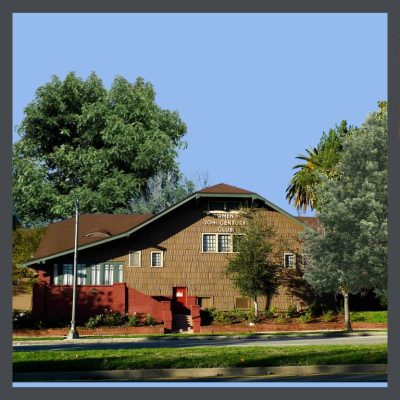 The Big Book, (Jane’s name for it) AKA, BUNGALOW: THE ULTIMATE ARTS & CRAFTS HOME, is my favorite because it contains so many images of the house I lovingly restored & left behind in California after my crushing defeat in my fight to save a neighborhood building. Jane & Linda & I spent the day shooting which was fun & exhausting. I waited with great anticipation for the book to be published so I could see my house as well as the other houses in the neighborhood which Jane & Linda had shot several months earlier- dodging the Halloween decorations that had adorned many facades. I was pleased to see my house so well represented & amused by some of the accompanying copy.
The Big Book, (Jane’s name for it) AKA, BUNGALOW: THE ULTIMATE ARTS & CRAFTS HOME, is my favorite because it contains so many images of the house I lovingly restored & left behind in California after my crushing defeat in my fight to save a neighborhood building. Jane & Linda & I spent the day shooting which was fun & exhausting. I waited with great anticipation for the book to be published so I could see my house as well as the other houses in the neighborhood which Jane & Linda had shot several months earlier- dodging the Halloween decorations that had adorned many facades. I was pleased to see my house so well represented & amused by some of the accompanying copy.
The exterior of my house is pictured on page 107, with another from my neighborhood. The Arts & Crafts clubhouse of the Woman’s Club to which I belonged is on page 100. The sisters of the man who built my house raised the money to erect the clubhouse by performing the skits & songs that they wrote. 100 years later I had the privilege of walking in a fashion show to raise money to restore & preserve that same building.
My sunroom is pictured on page 161 with a Moroccan table which was recently pitched after out attempt to rid it of termites. (I live in Florida now! If you have any clue as to how I might be able to get another one of these, Please let me know.) My living room is on page 181. I sold the couch & matching chair when we left Eagle Rock because it was painfully uncomfortable. We had to take it apart to get it out the door & there was a dead, fossilized rat in it. That wasn’t in any of the books!
To buy this book, you’re going to have to search for it in the various on-line booksellers. KITCHENS is available in Kindle but the rest can require some sleuthing. My fingers are crossed that the rest will be Kindled soon.
READ ALL JANE’S BOOKS ABOUT BUNGALOWS!
 BUNGALOW KITCHENS
BUNGALOW KITCHENS
Restoring the heart of the home.
 BUNGALOW BATHROOMS
BUNGALOW BATHROOMS
Everything you need to know to restore or create a beautiful & functional bungalow bathroom.
 BUNGALOW DETAILS: EXTERIOR
BUNGALOW DETAILS: EXTERIOR
What makes a bungalow.
 BUNGALOW DETAILS: INTERIOR
BUNGALOW DETAILS: INTERIOR
Your inspiration for a beautiful home.
& last but not least
 LINOLEUM
LINOLEUM
It’s not vinyl!

STAY IN THE BUNGALOW KNOW!!!
Sign up for our newsletter & receive our FREE E-book, 7 VITAL Things to Do Before You Hire a Contractor.
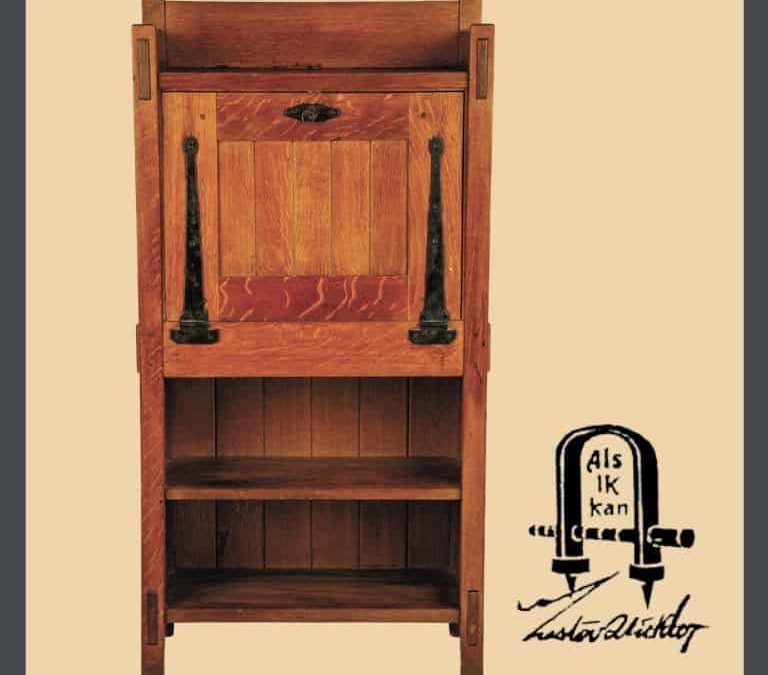
by bungalow101 | May 16, 2022 | The arts & the crafts, The History
by Janet Lea Haddock CID #4333
Instructional Specialist of Interior Design
Anne Arundel Community College
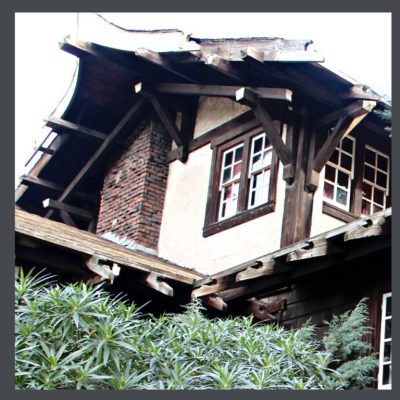 These two words are tossed around today by Realtors, consumers, builders & designers. We say them… “I love arts and crafts furniture”, we ask for them… “I want to buy an Arts & Crafts bungalow”, but are those two words understood? Do those requests come from a place of knowledge or from a think tank somewhere deciding that Arts & Crafts i.e., Craftsman was going to be a new historic-based trend to sell merchandise and home design. Is the term “Arts & Crafts” a style, a movement, or something else?
These two words are tossed around today by Realtors, consumers, builders & designers. We say them… “I love arts and crafts furniture”, we ask for them… “I want to buy an Arts & Crafts bungalow”, but are those two words understood? Do those requests come from a place of knowledge or from a think tank somewhere deciding that Arts & Crafts i.e., Craftsman was going to be a new historic-based trend to sell merchandise and home design. Is the term “Arts & Crafts” a style, a movement, or something else?
To be a loyalist to this movement when browsing the aisles of big box stores can be challenging. The undisciplined explosion of furnishings for the home was born from the industrial revolution. It brought garish results with a lack of proportion & overly embellished decorative details. Mass production was now possible so furniture, carpet & drapery, formerly only affordable to the wealthy, was now within reach of the common man.
THE ARTS & CRAFTS MOVEMENT THAT BIRTHED THE BUNGALOW
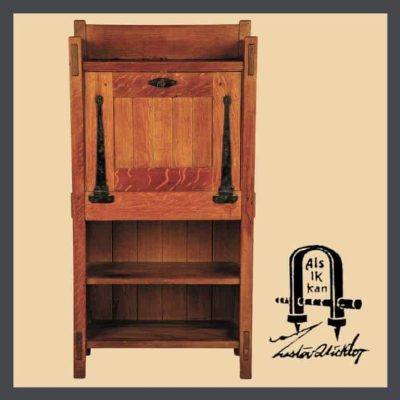 Today we celebrate those individuals who said, “no thank you” & gave birth to the Arts & Crafts movement. It was really a restoration, a return to “master craftsmanship” in furniture construction which led to home construction & design. It was a rejection to theatrical excessiveness. The mission was “truth to materials.” It embraced exposed joinery, natural finishes, simple lines while combining materials like metal & wood. Appreciating the beauty of those materials in a far simpler format that could be affordable to the masses was the intent. The term “mission furniture” is about the mission of truth to materials, but often mistaken for furnishings used in religious facilities known as missions, especially prevalent in California. Now how does this tie into “the Bungalow”?
Today we celebrate those individuals who said, “no thank you” & gave birth to the Arts & Crafts movement. It was really a restoration, a return to “master craftsmanship” in furniture construction which led to home construction & design. It was a rejection to theatrical excessiveness. The mission was “truth to materials.” It embraced exposed joinery, natural finishes, simple lines while combining materials like metal & wood. Appreciating the beauty of those materials in a far simpler format that could be affordable to the masses was the intent. The term “mission furniture” is about the mission of truth to materials, but often mistaken for furnishings used in religious facilities known as missions, especially prevalent in California. Now how does this tie into “the Bungalow”?
AMERICAN BUNGALOW STYLE (1905-1930)
 Characteristics. Simple design, sparse decoration, and natural materials—these were the essential components of the Bungalow style.
Characteristics. Simple design, sparse decoration, and natural materials—these were the essential components of the Bungalow style.
Materials. The materials used for the bungalow’s exterior usually suggested warmth & informality. …
That description is taken directly from the Wentworth Studio, a firm of architects and builders, specializing in restoring historic properties.
The concept of bungalows started with structures that were created in India for a British officer’s home (1890). They were not necessarily small houses in the beginning (circa. 1890), but grew (or shrank) to be a one-story home, typically a smaller square footage with deep overhangs. The late 1800s & the turn of the century, having no significant HVAC & limited use of electricity, used the overhangs in the roofing as a means of interior comfort management for seasonal weather. Meanwhile Sears Roebuck & Co. had begun to send catalogs directly to consumers. Home plans for bungalows appeared in 1908 for the first time…
RENOVATING YOUR BUNGALOW- CHOOSE AUTHENTIC ARTS & CRAFTS FINISHES
So what are we learning from this information? When renovating a bungalow…seek out authentic sources for the finish details like hardware, tile, light fixtures, etc. Truth to materials means to appreciate & use the materials as they were meant to be seen. Walls were painted, woodwork was stained. Brick was chosen for its color, not colorized once in place. The deep overhangs limited sunlight from entering the rooms so warm colors were painted on the walls. Wood darkens over time as it ages. When we see an Arts & Crafts bungalow today, perhaps the dark wood originally wasn’t as dark…light colored simple drapery hung at the windows. Built-ins provided an efficient use of space with glass doors, often leaded glass, giving both storage & beauty.
Gustav Stickley is celebrated & attached to this movement & justifiably so, but he isn’t the only Craftsman tied into the Arts & Crafts movement. History includes the Aesthetic movement within it bringing William Morris, Charles Rennie Mackintosh, Greene & Greene architects & early Frank Lloyd Wright in the credits. Art Nouveau, French based was happening simultaneously & its influence is apparent in many bungalows. All bungalows are not of a singular style because of those influences. They also embraced Victorian & Spanish influences, especially in the West & Southwest where weather conditions were friendly to stucco exteriors & large expanses of glass. The common threads are the physical size, predominantly single-story living, front porches where people enjoyed socializing with passersby & the charm they exhude. Dining rooms were large, living rooms & bedrooms…not so large. Closets…well, let’s not go there.
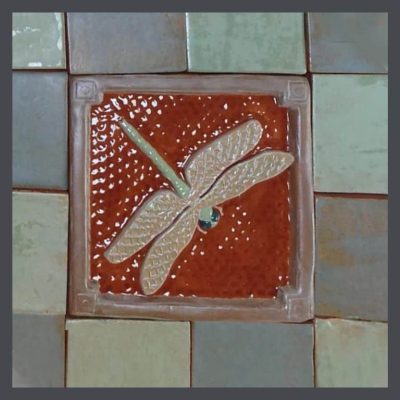 As we walk down the aisles of Home Depot, Lowes or Menards…wherever your shopping options are as you repair & improve your bungalow, a person can find stock tile that can be laid in patterns to complement that era. Perhaps a splurge of 3-5 pieces of vintage tile to complete an authentic visual could be in the budget. Linoleum, which you can read about here, is authentic to this era & is considered one of the earliest sustainable material finishes for flooring. Choose your pattern carefully.
As we walk down the aisles of Home Depot, Lowes or Menards…wherever your shopping options are as you repair & improve your bungalow, a person can find stock tile that can be laid in patterns to complement that era. Perhaps a splurge of 3-5 pieces of vintage tile to complete an authentic visual could be in the budget. Linoleum, which you can read about here, is authentic to this era & is considered one of the earliest sustainable material finishes for flooring. Choose your pattern carefully.
Resist the urge to paint the woodwork, but should it be your only option (or sometimes the best option) study the charts in your local paint supplier & read my articles about era appropriate colors. Patience in making the right choice is a virtue & celebrated by your fellow Arts & Crafts lovers. Avoid synthetic materials. They did not exist during this time. One can still have modern convenience without man made finishes. Insert your personal style through your accessories & art as furnishings are easily removable & do not compromise the space.
The bungalow was a great option for the young family in its day. It provided all the basic necessities a growing family needed in an atmosphere of charm & quality craftsmanship. As technology soars at the speed of light, maybe this is our way of pulling back & slowing down a bit…we want to sit on our porches & talk to our neighbors again…for some, it may be their first time.
TIP: FOR SOME GREAT A&C RESOURCES, VISIT OUR PAGE ON ARCHITECTURAL SALVAGE HERE.
 STAY IN THE BUNGALOW KNOW!!!
STAY IN THE BUNGALOW KNOW!!!
Sign up for our newsletter & receive our FREE E-book, 7 VITAL Things to Do Before You Hire a Contractor.

 The story of the Chicago bungalow isn’t about the houses, it’s about the humanity. I call it, “Grits & girdles history.”
The story of the Chicago bungalow isn’t about the houses, it’s about the humanity. I call it, “Grits & girdles history.” There were a great many influences that resulted in the Chicago bungalow, the first of course, being the Arts & Crafts Movement in England, a pushback against the overproduction of shoddy goods that characterized the Industrial Revolution.
There were a great many influences that resulted in the Chicago bungalow, the first of course, being the Arts & Crafts Movement in England, a pushback against the overproduction of shoddy goods that characterized the Industrial Revolution. The next great influence was the Chicago Fire of 1871, which started in a barn & burned for over a day, killing 300 people. Because of the pressure to build houses to accommodate the growing population, buildings had been constructed using quickly assembled, cheaply constructed balloon-framing, with studs running from the foundation to the roof. Fire travels upward & there was nothing to stop it as it roared up the walls & turned the houses to ash, making a third of the city homeless. After this disaster, the city enacted new building codes & rapidly rebuilt the city according to those codes. With brick.
The next great influence was the Chicago Fire of 1871, which started in a barn & burned for over a day, killing 300 people. Because of the pressure to build houses to accommodate the growing population, buildings had been constructed using quickly assembled, cheaply constructed balloon-framing, with studs running from the foundation to the roof. Fire travels upward & there was nothing to stop it as it roared up the walls & turned the houses to ash, making a third of the city homeless. After this disaster, the city enacted new building codes & rapidly rebuilt the city according to those codes. With brick. The images that you see here are created by Wonder City Studio by Phil Thompson & his wife Katie who are obviously in love with their town. He has created many drawings of Chicago buildings of all types, including capturing the sweet, sturdy hominess of the bungalow.
The images that you see here are created by Wonder City Studio by Phil Thompson & his wife Katie who are obviously in love with their town. He has created many drawings of Chicago buildings of all types, including capturing the sweet, sturdy hominess of the bungalow. STAY IN THE BUNGALOW KNOW!!!
STAY IN THE BUNGALOW KNOW!!!


 From their framing to their siding to their doors & windows to their built-ins & their flooring, our old houses, are built of old growth wood. Thousands of board feet of it.
From their framing to their siding to their doors & windows to their built-ins & their flooring, our old houses, are built of old growth wood. Thousands of board feet of it. Let’s start with the Redwood, one class being the oldest plants on earth, living from about 800 to 3,200 years. On the west coast, before they were chopped to build our houses, they played an important part in the lives of early indigenous peoples who revered them, building structures from fallen trees. Native elder Minnie Reeves called them “a special gift from the Great Creator. Destroy these trees and you destroy the Creator’s love . . . and you will eventually destroy mankind.”
Let’s start with the Redwood, one class being the oldest plants on earth, living from about 800 to 3,200 years. On the west coast, before they were chopped to build our houses, they played an important part in the lives of early indigenous peoples who revered them, building structures from fallen trees. Native elder Minnie Reeves called them “a special gift from the Great Creator. Destroy these trees and you destroy the Creator’s love . . . and you will eventually destroy mankind.” The Domesday Book of 1086, a survey ordered by William the Conqueror to record his holdings, indicated a forest cover of 15%, By the start of the next millennium, this coverage had dropped to 5%.
The Domesday Book of 1086, a survey ordered by William the Conqueror to record his holdings, indicated a forest cover of 15%, By the start of the next millennium, this coverage had dropped to 5%.  Trees are planted in man-made forests with the purpose of generating a large amount of product, fast. These farms do not replicate the ecology of the natural forest. Generally they are one species only, & all the trees are planted at the same time. The trees are planted in rows spaced to allow maximum sunlight & water exposure so they grow very fast. The old forests allowed trees to grow slowly, putting on more tightly-packed growth rings
Trees are planted in man-made forests with the purpose of generating a large amount of product, fast. These farms do not replicate the ecology of the natural forest. Generally they are one species only, & all the trees are planted at the same time. The trees are planted in rows spaced to allow maximum sunlight & water exposure so they grow very fast. The old forests allowed trees to grow slowly, putting on more tightly-packed growth rings Much of this mutual adaptation involves microorganisms, the fungi that break down the fiber of the dead trees & turn them into nutritious soil, but also form a communication network for the trees. Watch this short
Much of this mutual adaptation involves microorganisms, the fungi that break down the fiber of the dead trees & turn them into nutritious soil, but also form a communication network for the trees. Watch this short 
 What seems like a lifetime ago, with a great amount of help from my friends in the 3 areas that make up the bungalow neighborhood of Seminole Heights, in Tampa, Florida, I produced an American Bungalow Magazine event. I had coaxed, cajoled, pleaded with the editor to have genius photographer, Alex Vertikoff come to Central Florida to shoot our houses. I coordinated with 4 other neighborhoods in Tampa, St. Petersburg & Lakeland to make it worth their while to drive all the way across the country. Publisher John Brinkmann came to speak to us at a wonderful event in our historic church.
What seems like a lifetime ago, with a great amount of help from my friends in the 3 areas that make up the bungalow neighborhood of Seminole Heights, in Tampa, Florida, I produced an American Bungalow Magazine event. I had coaxed, cajoled, pleaded with the editor to have genius photographer, Alex Vertikoff come to Central Florida to shoot our houses. I coordinated with 4 other neighborhoods in Tampa, St. Petersburg & Lakeland to make it worth their while to drive all the way across the country. Publisher John Brinkmann came to speak to us at a wonderful event in our historic church. The neighborhoods pitched in, volunteering their bungalows for the project. I recruited writers for all the articles & each author (or group of authors) gathered material & researched their areas.
The neighborhoods pitched in, volunteering their bungalows for the project. I recruited writers for all the articles & each author (or group of authors) gathered material & researched their areas. In the center of Tampa is a farm with a bungalow farmhouse, built by Sicilian immigrants, Salvatore & Vittoria Giunta, who arrived in Tampa in 1907. Peasant farmers, they hoped for a better life for themselves & their children in American. Work was plentiful in Ybor City in the cigar factories & farms & they worked at a variety of jobs, saving money until they could buy land. Self-sufficient, they raised heirloom vegetables & herbs with which they fed their family & sold the surplus to supplement their income. At one time, this area, now residential was dubbed “the breadbasket of Ybor,” providing food for up to 10,000 cigar factory workers. After time they purchased more land & in 1924, the house was built just in time for the family to enjoy their Christmas together. The farm up to this day, almost 100 years later, is still being worked by the two granddaughters, who live in the old farmhouse.
In the center of Tampa is a farm with a bungalow farmhouse, built by Sicilian immigrants, Salvatore & Vittoria Giunta, who arrived in Tampa in 1907. Peasant farmers, they hoped for a better life for themselves & their children in American. Work was plentiful in Ybor City in the cigar factories & farms & they worked at a variety of jobs, saving money until they could buy land. Self-sufficient, they raised heirloom vegetables & herbs with which they fed their family & sold the surplus to supplement their income. At one time, this area, now residential was dubbed “the breadbasket of Ybor,” providing food for up to 10,000 cigar factory workers. After time they purchased more land & in 1924, the house was built just in time for the family to enjoy their Christmas together. The farm up to this day, almost 100 years later, is still being worked by the two granddaughters, who live in the old farmhouse. Make no mistake about it. This is a farmhouse. The floors are not glossy quartersawn oak but are covered with linoleum & the usual Stickley pieces that you see pictured in American Bungalow are not in evidence. I spent 2 days helping the sisters stage the house for the shoot (No, Alex didn’t know about know this!) I pulled all the family antiques- a charming deco armoire, an old tricycle, a child’s chair, from the bedrooms & arranged them in the family gathering room off the kitchen. A century ago. their father had made a wooden boat to sail down the flooded Tampa streets, & I pulled it from a closet & had a shelf built for it to be mounted over a quilt-covered chair in the corner.
Make no mistake about it. This is a farmhouse. The floors are not glossy quartersawn oak but are covered with linoleum & the usual Stickley pieces that you see pictured in American Bungalow are not in evidence. I spent 2 days helping the sisters stage the house for the shoot (No, Alex didn’t know about know this!) I pulled all the family antiques- a charming deco armoire, an old tricycle, a child’s chair, from the bedrooms & arranged them in the family gathering room off the kitchen. A century ago. their father had made a wooden boat to sail down the flooded Tampa streets, & I pulled it from a closet & had a shelf built for it to be mounted over a quilt-covered chair in the corner. The plaque installed by the County reads:
The plaque installed by the County reads:

 This book, BUNGALOW: THE ULTIMATE ARTS & CRAFTS HOME, was Jane’s most impressive work & it is majestic, with 285 large, glossy pages. She referred to it as “The Big Book of Bungalows” & I’m not certain that she was enthralled with the publisher’s final choice of title.
This book, BUNGALOW: THE ULTIMATE ARTS & CRAFTS HOME, was Jane’s most impressive work & it is majestic, with 285 large, glossy pages. She referred to it as “The Big Book of Bungalows” & I’m not certain that she was enthralled with the publisher’s final choice of title. Jane introduces the book with some beautiful shots of bungalows by Linda Svendsen, including the impressive staircase of Jane’s bungamansion, the Sunset House in Oakland. Walking up these stairs, so sexy that they made the cover of American Bungalow, photographed by Alex Vertikoff, is an awesome experience. I wish this word had not been appropriated to mean, “like, totally cool” because the huge Doug Fir staircase is truly, “extremely impressive or daunting; inspiring great admiration, apprehension, or fear.” The workmanship is masterful, the dark wood lovely, & when you walk up these stairs, you are cocooned in the world of the wealthy 100 years ago. (Jane mentions, the builder was the owner of a lumber company so he got the wood wholesale, but still.)
Jane introduces the book with some beautiful shots of bungalows by Linda Svendsen, including the impressive staircase of Jane’s bungamansion, the Sunset House in Oakland. Walking up these stairs, so sexy that they made the cover of American Bungalow, photographed by Alex Vertikoff, is an awesome experience. I wish this word had not been appropriated to mean, “like, totally cool” because the huge Doug Fir staircase is truly, “extremely impressive or daunting; inspiring great admiration, apprehension, or fear.” The workmanship is masterful, the dark wood lovely, & when you walk up these stairs, you are cocooned in the world of the wealthy 100 years ago. (Jane mentions, the builder was the owner of a lumber company so he got the wood wholesale, but still.) This chapter addresses, what is a bungalow? Well, it originated in India, & ended up in California inspired by a socialist design movement in Britain in the late 1800’s. Explaining that architecture isn’t simple, she answers this question by encouraging us to “Think outside the chicken” -by reading her book & viewing the images, we will just come to KNOW. It worked for me & whenever I feel wobbly, I come back to this book to get straightened out.
This chapter addresses, what is a bungalow? Well, it originated in India, & ended up in California inspired by a socialist design movement in Britain in the late 1800’s. Explaining that architecture isn’t simple, she answers this question by encouraging us to “Think outside the chicken” -by reading her book & viewing the images, we will just come to KNOW. It worked for me & whenever I feel wobbly, I come back to this book to get straightened out. Ah! California, where the bungalow reached its full potential. She visits Northern & Southern California & it is here where we see my house in Eagle Rock.
Ah! California, where the bungalow reached its full potential. She visits Northern & Southern California & it is here where we see my house in Eagle Rock. This is the longest chapter of BUNGALOW: THE ULTIMATE ARTS & CRAFTS HOME & I don’t want to wear you out, so I’ll cover it in one section.
This is the longest chapter of BUNGALOW: THE ULTIMATE ARTS & CRAFTS HOME & I don’t want to wear you out, so I’ll cover it in one section. The Big Book, (Jane’s name for it) AKA, BUNGALOW: THE ULTIMATE ARTS & CRAFTS HOME, is my favorite because it contains so many images of the house I lovingly restored & left behind in California after my crushing defeat in my fight to save a neighborhood building. Jane & Linda & I spent the day shooting which was fun & exhausting. I waited with great anticipation for the book to be published so I could see my house as well as the other houses in the neighborhood which Jane & Linda had shot several months earlier- dodging the Halloween decorations that had adorned many facades. I was pleased to see my house so well represented & amused by some of the accompanying copy.
The Big Book, (Jane’s name for it) AKA, BUNGALOW: THE ULTIMATE ARTS & CRAFTS HOME, is my favorite because it contains so many images of the house I lovingly restored & left behind in California after my crushing defeat in my fight to save a neighborhood building. Jane & Linda & I spent the day shooting which was fun & exhausting. I waited with great anticipation for the book to be published so I could see my house as well as the other houses in the neighborhood which Jane & Linda had shot several months earlier- dodging the Halloween decorations that had adorned many facades. I was pleased to see my house so well represented & amused by some of the accompanying copy.
 These two words are tossed around today by Realtors, consumers, builders & designers. We say them… “I love arts and crafts furniture”, we ask for them… “I want to buy an Arts & Crafts bungalow”, but are those two words understood? Do those requests come from a place of knowledge or from a think tank somewhere deciding that Arts & Crafts i.e., Craftsman was going to be a new historic-based trend to sell merchandise and home design. Is the term “Arts & Crafts” a style, a movement, or something else?
These two words are tossed around today by Realtors, consumers, builders & designers. We say them… “I love arts and crafts furniture”, we ask for them… “I want to buy an Arts & Crafts bungalow”, but are those two words understood? Do those requests come from a place of knowledge or from a think tank somewhere deciding that Arts & Crafts i.e., Craftsman was going to be a new historic-based trend to sell merchandise and home design. Is the term “Arts & Crafts” a style, a movement, or something else? Today we celebrate those individuals who said, “no thank you” & gave birth to the Arts & Crafts movement. It was really a restoration, a return to “master craftsmanship” in furniture construction which led to home construction & design. It was a rejection to theatrical excessiveness. The mission was “truth to materials.” It embraced exposed joinery, natural finishes, simple lines while combining materials like metal & wood. Appreciating the beauty of those materials in a far simpler format that could be affordable to the masses was the intent. The term “mission furniture” is about the mission of truth to materials, but often mistaken for furnishings used in religious facilities known as missions, especially prevalent in California. Now how does this tie into “the Bungalow”?
Today we celebrate those individuals who said, “no thank you” & gave birth to the Arts & Crafts movement. It was really a restoration, a return to “master craftsmanship” in furniture construction which led to home construction & design. It was a rejection to theatrical excessiveness. The mission was “truth to materials.” It embraced exposed joinery, natural finishes, simple lines while combining materials like metal & wood. Appreciating the beauty of those materials in a far simpler format that could be affordable to the masses was the intent. The term “mission furniture” is about the mission of truth to materials, but often mistaken for furnishings used in religious facilities known as missions, especially prevalent in California. Now how does this tie into “the Bungalow”? As we walk down the aisles of Home Depot, Lowes or Menards…wherever your shopping options are as you repair & improve your bungalow, a person can find stock tile that can be laid in patterns to complement that era. Perhaps a splurge of 3-5 pieces of vintage tile to complete an authentic visual could be in the budget.
As we walk down the aisles of Home Depot, Lowes or Menards…wherever your shopping options are as you repair & improve your bungalow, a person can find stock tile that can be laid in patterns to complement that era. Perhaps a splurge of 3-5 pieces of vintage tile to complete an authentic visual could be in the budget.